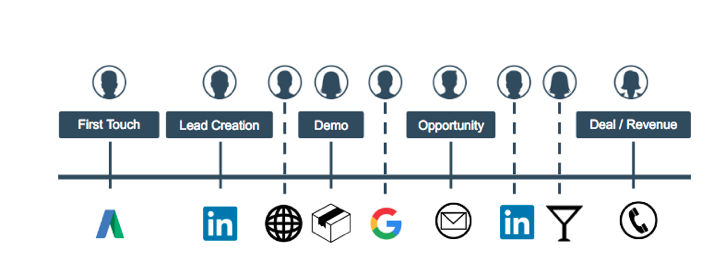Omni-Channel Measurement In An ABM World
One of the major benefits of Account-Based Marketing over traditional lead based marketing is the ability to spend more time and resources crafting a highly relevant and impactful experience for your target accounts. It’s not spray-and-pray; rather, it’s focusing on great fits, doing your research, and addressing the specific pain points that your prospect is experiencing.
To create this great, personalized experience for their target accounts, marketers must coordinate their efforts to meet their prospects where they are. Increasingly, that means executing both online and offline.
Because of this evolving nature of marketing execution (e.g. the resurgence of direct mail, coordinated multi-channel plays), omni-channel measurement—measuring all channels the same way, both digital and offline—is increasingly important for organizations doing ABM.
To do effective omni-channel measurement in an account-based world, organizations must 1) dynamically map leads to accounts and 2) centrally track and measure all channels with granularity.
Dynamically Mapping Leads to Accounts
One of the foundations of account-based measurement—whether you’re executing multi-channel plays or otherwise—is connecting leads (individuals) to accounts (their organization).
B2B deals, even if you’re selling to SMBs, involve multiple stakeholders. There’s the user or practitioner, technical implementation, a decision maker, and maybe a researcher and legal team if you’re dealing with personal data. You need to be sure that your measurement system treats all of these people as one account on the same journey. They’ll certainly have different pain points and needs, but you’ll need to sell them all.
It’s even better and more accurate when this mapping is done dynamically. Manually remembering to add leads to opportunities and recalculating credit is time better spent elsewhere. Dynamic lead-to-account mapping ensures a cleaner CRM, more accurate data, and more time making sense of the data instead of making the data.
Measuring with the context of both individuals and accounts allows marketers to understand critical ABM metrics like account coverage (number of key personas involved in the deal) and overall account engagement (frequency, recency, quantity, etc. of engagement)
Accurate Omni-Channel Measurement
Once you have that foundation, ABM marketers need a centralized measurement system that takes in data inputs from a variety of sources, both digital and offline—the more granular, the better. We’ll cover just a handful of those data sources.
Ad Networks. Digital ad networks, like the various social media, search, or display ad networks, are key components of any ABM strategy. Advanced targeting capabilities make them effective and efficient ways of getting specific messages to specific groups of target accounts.
Of course, not all methods of measuring the impact of these ad networks are created equal. One method, for example, is to use hidden form fields to drop prospects into CRM campaigns. This gives you limited, high level data like lead source and the URL in which the form was filled out. Another method is to use UTM parameters to pass along a few pieces of key information like the marketing channel, the ad campaign name, term (mostly for search), and ad content.
At the most granular level of data, direct connections to the ad network API enable marketers to automatically have access to complete and granular data, including spend down to the specific ad.
Offline (field marketing, direct mail, events, etc.). The increase in offline marketing efforts as part of an ABM program has created a new challenge for many marketers trying to accurately measure their performance. At first it can seem odd to try to compare the impact of a gift box to the impact of an email or a display ad.
However, one advantage of offline efforts is their simplicity. They often don’t have as many layers compared to a search ad where you’re bidding on keywords with different ad groups and content. In fact, lead uploads from events and field marketing or even content syndication are exactly what CRM campaigns are designed to handle. They simply don’t need the multiple dimensions of data that many digital channels require.
CRM campaigns are a great translator, converting offline engagement into digital data, which can then sit side-by-side with the rest of your digital data.
Sales activity. It might be strange to think of sales activity like outbound phone calls and emails as part of an Account-Based Marketing strategy—sales is in the name, after all. But for many organizations, outbound sales development reports into the marketing function and they have a significant impact on marketing metrics.
Here is a simple buyer journey:

Shouldn’t the outbound email be included in your measurement?
As an added bonus, including sales activity in your measurement will help your organization make sense of and reduce the amount of credit that “Direct” receives. A common use case is that someone on the sales team will call into a target account and during the phone call, the prospect will go to your website to check you out. Your data will show a web visit from Direct, but in reality, the sales activity drove that visit and the activity that followed.
True omni-channel measurement should include sales activity.
Without a doubt there are more channels involved in your ABM strategy, but for now, we’ll just cover these three groups of activity. When you’re thinking about how you’re measuring your Account-Based Marketing, it’s important to have your technology match the way your prospects experience the buyer journey. They buy in the context of other stakeholders and they don’t differentiate engagement by where it takes place—they are all just various steps in the same journey.